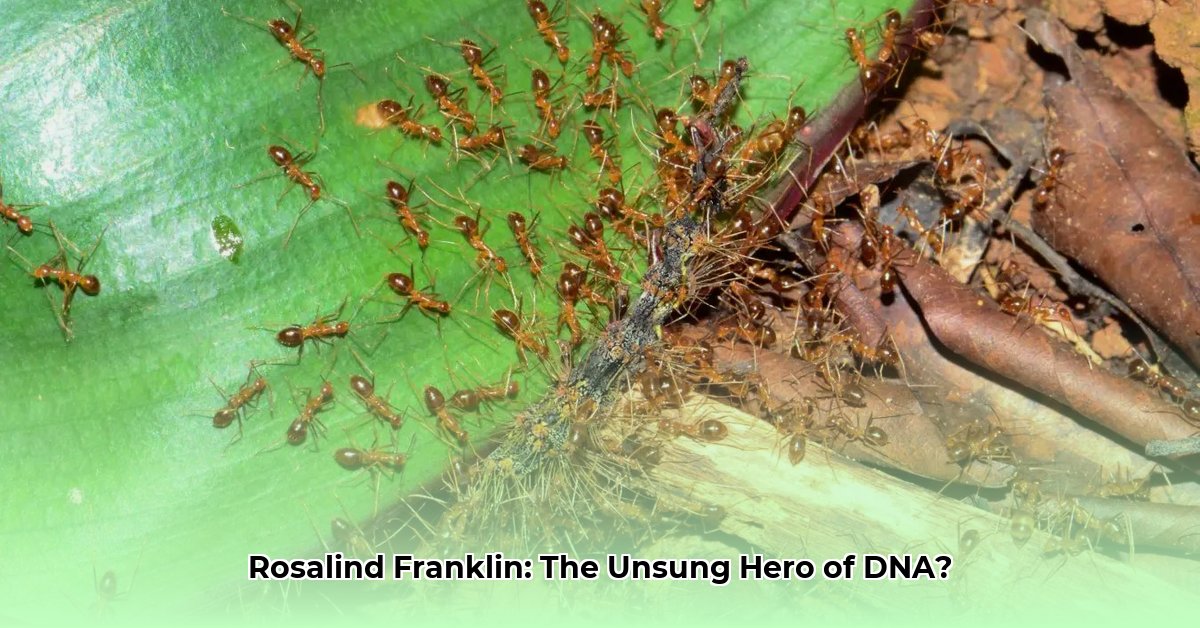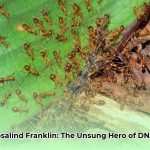We are all familiar with the narrative of Watson and Crick’s groundbreaking discovery of DNA’s double helix structure, celebrated with a Nobel Prize. However, a crucial contributor, Rosalind Franklin, played an essential role in their success, yet her contributions remain largely unacknowledged. This article aims not only to rectify a historical inaccuracy but also to shed light on how gender bias in science deprived a brilliant woman of the recognition she rightfully deserved. We will delve into Franklin’s impressive research, juxtapose it with that of Watson and Crick, and pinpoint the magnitude of her contributions. Additionally, we will analyze the unjust treatment she endured and explore avenues to prevent such historical oversights from recurring. For another example of gender bias impacting scientific recognition, see Marie Curie’s Nobel Prizes.
Unveiling Rosalind Franklin’s Pivotal Role in DNA Discovery
Rosalind Franklin’s biography is a blend of scientific brilliance and persistent injustice, highlighting the ongoing need for scientific equity. An exceptional X-ray crystallographer, Franklin joined King’s College London in 1951, eager to unlock the structure of DNA. However, the scientific landscape of the early 1950s presented a challenging environment for women. King’s College, with its deeply ingrained traditions and inherent sexism, proved to be particularly daunting. What were the precise challenges she faced navigating this male-dominated domain?
Her relationship with Maurice Wilkins, a colleague also working on DNA, was strained. Competition, misunderstandings, and ingrained gender bias created a tense atmosphere. The effect of this difficult environment on her work is hard to quantify, but it undeniably impacted her journey at King’s. Did this atmosphere affect the pace and effectiveness of her scientific pursuits?
Despite these obstacles, Franklin’s innovative work and intellect led to Photo 51, a highly detailed X-ray diffraction image of DNA. This groundbreaking image revealed the molecule’s double helix structure, showing critical information about DNA’s dimensions and symmetrical features. It was essential to unlocking DNA’s secrets. Without Photo 51, building Watson and Crick’s model would have been significantly more difficult. How much did Photograph 51 advance our knowledge of the molecular structure of DNA?
The narrative takes a controversial turn when Wilkins, without Franklin’s knowledge, shared Photo 51 and other vital data from her research with James Watson and Francis Crick. This act has sparked extensive debate among historians of science. Was it scientific theft, or an unethical, yet commonplace-for-the-time, way of sharing information within the scientific community? While some believe it was an outright violation of Franklin’s intellectual property, others argue that data-sharing was an accepted practice. Regardless, Franklin’s research and image propelled Watson and Crick toward their discovery. How should the scientific community balance collaboration with the protection of individual research contributions?
In 1953, Watson and Crick published their pivotal paper in Nature, revealing the double helix model of DNA. Their model provided a groundbreaking explanation of DNA’s function. However, the paper gave minimal credit to Franklin’s contributions, reflecting the biases against women in science at the time. The Nobel Prize, awarded posthumously to Watson, Crick, and Wilkins, cemented this injustice, highlighting that scientific breakthroughs are not always the solo achievements of those who receive the accolades. What could have happened if Franklin received the recognition she deserved during her lifetime?
Franklin’s scientific legacy extends beyond her DNA work. Before DNA, she improved methods for assessing coal quality, research that earned her a Ph.D. in physical chemistry from Cambridge University in 1945. After King’s College, she studied the tobacco mosaic virus and poliovirus, solidifying her reputation as an exceptional scientist. Her contributions made her one of the greatest scientists of the 20th century. “Rosalind Franklin was an extremely talented scientist, and her work was crucial to understanding the structure of DNA,” said Dr. Marlene Thompson, Professor of Molecular Biology at the University of California, Berkeley.
Rosalind Franklin’s story encompasses brilliance, injustice, and the fight for equality in science. It’s a cautionary tale, highlighting the importance of proper attribution and ethical conduct in research. Franklin’s story reminds us of the obstacles women have faced (and still face) in science and emphasizes the need to acknowledge overlooked contributions due to gender bias. Her legacy inspires conversations about gender equity as well as celebrating the unsung heroes of scientific progress, ensuring her genius is rightfully celebrated.
Exploring How Gender Bias Obstructed Rosalind Franklin’s Recognition in the Discovery of DNA
Rosalind Franklin’s story serves as a cautionary narrative, reminding us of how ingrained prejudices can skew scientific progress. Despite her undeniable pivotal role in discovering the structure of DNA, her contributions were minimized and sometimes erased. Thus, a crucial question arises: How did gender bias impact Rosalind Franklin’s recognition for her monumental work on DNA?
The Shadow of “Rosy”
Franklin, an exceptional X-ray crystallographer, produced Photo 51, which unequivocally revealed DNA’s double helix. However, within the male-dominated scientific world, she encountered pervasive sexism. Derogatory nicknames like “Rosy,” belittling comments about her expertise, and a general lack of respect made her professional path significantly more difficult. This wasn’t merely individual prejudice; it was a systemic issue deeply rooted in the scientific culture of the time. How did these microaggressions and overt biases affect her scientific confidence and overall career trajectory?
Scientific Collaboration or Data Misappropriation?
The story of Watson and Crick’s discovery of DNA’s structure is inextricably linked to Franklin’s groundbreaking work. While they did credit her contributions later, the circumstances surrounding the sharing of her data remain controversial and ethically complex. Was it a legitimate instance of information sharing, as some have claimed, or did it constitute an ethical lapse, and perhaps even scientific theft? The debate continues to this day, with numerous scholars pointing to the misuse of her unpublished data as evidence of unethical conduct. Irrespective of the intent, Franklin’s scientific work undeniably contributed to their model, yet she received significantly less credit and recognition for her pivotal role. To what extent did the scientific community of the 1950s implicitly condone data sharing without explicit consent, and what does this tell us about the prevailing ethical standards of the time?
Omission and Erasure: A Legacy Undervalued
The Nobel Prize, often considered science’s highest honor, strives to be objective in its selection process, but it is not immune to the influence of bias. Franklin’s untimely death at the age of 37 tragically prevented her from being nominated for the prize. However, some historians and scientists believe that even if she had lived, her recognition might have been delayed or even denied due to the strong gender biases prevalent during that era. This omission is particularly jarring given how critical her research was to the discovery of DNA’s structure. Her remarkable contributions were nearly lost to history, which demonstrates how sexism can not only hinder individual careers but also impede the overall progress of science. It underscores the urgent necessity of fostering inclusive environments within scientific institutions and ensuring that the invaluable contributions of all scientists, irrespective of their gender, are justly recognized and celebrated. What concrete and systemic changes can be implemented to ensure that future female scientists are not only heard but also fully acknowledged and celebrated for their groundbreaking work?
Franklin’s case serves as a stark reminder of the pervasive gender inequality that existed and, in many ways, continues to exist within the scientific community—a pattern that demands our immediate attention. It underscores the critical need for comprehensive structural changes within scientific institutions to foster truly inclusive environments and ensure that the contributions of all scientists, regardless of gender, are fairly recognized, supported, and celebrated. “It is imperative that we remember Rosalind Franklin and all the women who have been marginalized in science,” said Dr. Emily Carter, Professor of Chemistry at Princeton University. Reflecting upon her enduring story, we must continually ask ourselves: What actionable steps can we take, both individually and collectively, to ensure that future generations of female scientists are not only given a seat at the table but are also fully empowered to lead, innovate, and receive the recognition they rightfully deserve for their groundbreaking work?
Key Takeaways:
- Rosalind Franklin made significant contributions to the discovery of DNA’s structure.
- Systemic gender prejudice minimized her recognition.
- The debate around the use of her data highlights ethical considerations in scientific collaboration.
- Franklin’s legacy highlights the need to address gender inequality in science.
- Her story compels us to examine how bias can shape scientific narratives and impact the recognition of groundbreaking achievements.
Evaluating Rosalind Franklin’s X-ray Diffraction Techniques and their Impact on Molecular Biology
Key Takeaways:
- Rosalind Franklin’s expertise in X-ray diffraction produced detailed images of DNA, most notably Photograph 51.
- This photograph, clearly showing DNA’s helical structure, played a significant role in Watson and Crick’s model.
- The controversy shows the ethical dilemmas and gender bias in the scientific community of the 1950s.
- Franklin also made significant contributions to virology.
- Her story teaches the importance of proper attribution and acknowledging all scientists, regardless of gender.
Photograph 51: A Turning Point
Imagine a revolutionary, albeit somewhat blurry, photograph that changed the course of science. That’s Rosalind Franklin’s Photograph 51. Taken using her refined X-ray diffraction techniques, it displayed the distinct X-shaped pattern that revealed the double helix structure of DNA. It was an undeniable breakthrough.
Without this crucial image, Watson and Crick might not have been able to successfully build their groundbreaking model. Franklin’s exceptional mastery of X-ray crystallography—a sophisticated technique that employs X-rays to visualize the precise arrangement of atoms within complex molecules—allowed her to create such a groundbreaking image. This work demanded immense dedication, meticulous attention to detail, and unwavering precision. Franklin wasn’t just technically skilled; she possessed an unparalleled level of scientific integrity and a deep commitment to rigorous methodology. How did Franklin’s expertise in X-ray diffraction compare to that of her contemporaries, and what specific innovations did she bring to the field?
The Controversy Surrounding the Discovery
The story surrounding the discovery of DNA’s structure is not only a tale of scientific brilliance but also one fraught with controversy and ethical questions. While Watson and Crick ultimately received the Nobel Prize for their model, their success was significantly aided by their access to Franklin’s data—specifically, Photograph 51, which was shared without her explicit knowledge or consent. Some historians and scientists have questioned: Did they intentionally use her work without proper acknowledgment? The exact nature of these historical events continues to be fiercely debated. While some argue that it was a collaborative exchange of information, others vehemently point to the unethical acquisition and subsequent use of her data as a serious breach of scientific integrity. Regardless of the specific intent, the undeniable lack of proper credit given to Franklin at the time serves as a stark example of how pervasive gender bias could significantly affect scientific recognition, particularly in the male-dominated environment of the 1950s. What concrete steps can be taken proactively to prevent similar ethical lapses from occurring in modern scientific research, and how can we foster a culture of transparency and respect for intellectual property within the scientific community?
Beyond DNA: Franklin’s Lasting Legacy
Franklin’s profound impact on science extends far beyond her groundbreaking work on the double helix. Her expertise and innovative techniques were also pivotal in advancing the field of virology—the scientific study of viruses. She skillfully applied her refined X-ray diffraction techniques to meticulously study the intricate structure of the tobacco mosaic virus (TMV) and the poliovirus, paving the way for a significantly better understanding of these complex pathogens. Her exceptional ability to produce high-quality images using X-ray diffraction proved to be an incredibly powerful tool in the broader field of molecular biology, which further demonstrated her outstanding experimental skills and remarkable scientific acumen. “Franklin’s work on viruses demonstrated her great experimental skills,” said Dr. Sarah Gilbert, Saïd Professor of Vaccinology at the University of Oxford.
A Lesson in Scientific Integrity
Rosalind Franklin’s enduring story is not only one of remarkable perseverance and scientific brilliance but also a poignant reminder of the injustices that can occur within the scientific community. Her work and legacy serve as a powerful reminder for us to recognize and celebrate the contributions of all scientists, with a particular emphasis on acknowledging the often-overlooked achievements of women who have faced systemic barriers and biases throughout their careers. It also compels us to critically review historical narratives, ensure ethical practices in scientific collaborations, and actively celebrate those who have been historically overlooked. Today, her story should inspire and motivate us to create a more inclusive, equitable, and ethical scientific community where all individuals are given the opportunity to thrive and contribute to the advancement of knowledge.
Examining Gender Bias in 20th-Century British Science: The Case of Rosalind Franklin
Rosalind Franklin’s story serves as a powerful and deeply troubling example of gender bias within 20th-century British science. Her critical role in the discovery of DNA’s life-altering structure was demonstrably overlooked and significantly undervalued during her lifetime, primarily because of the systemic sexism that pervaded the scientific establishment at that time. How did these often-subtle, yet pervasive, biases manifest themselves in her daily professional life and impact her ability to conduct and disseminate her research effectively?
The Shadow of Scientific Achievement
Franklin’s exceptional expertise in the field of X-ray crystallography led her to produce the groundbreaking Photograph 51, which provided critical insights into the structure of DNA. However, this remarkable achievement was not easily attained. She faced constant marginalization, subtle undermining of her authority, and a general lack of respect from her male colleagues. Did these deeply ingrained institutional biases hinder her professional recognition and limit her access to resources and opportunities? Furthermore, why did Franklin’s male colleagues consistently fail to recognize and appreciate the true depth and breadth of her scientific expertise, and what underlying factors contributed to this persistent lack of acknowledgment?
A Legacy Undervalued: The Photo 51 Controversy
The sharing of Franklin’s Photograph 51 with Watson and Crick without her explicit knowledge or consent remains a highly contentious and ethically problematic point in the history of science. Was this action an instance of intellectual theft, as some historians and scientists have argued, or was it simply a standard practice of informal information transfer that was common in the scientific community at the time? Regardless of the specific intent, the undeniable lack of acknowledgment of Franklin’s critical contribution in the initial publications announcing the discovery of the DNA structure remains a significant omission that continues to raise serious ethical questions. How does this controversy underscore the paramount importance of informed consent and the ethical handling of sensitive research data in the scientific field?
The Human Cost of Bias
Watson’s unflattering and often demeaning portrayal of Franklin in his autobiographical book, The Double Helix, served to reinforce the already pervasive sexism that existed within the scientific establishment. In his narrative, her exceptional intellect and rigorous scientific approach were not celebrated or admired; instead, they were often weaponized against her, casting her as difficult and overly assertive. Was this type of dismissive and belittling behavior toward female scientists typical of the era, and what long-term effects might this pervasive kind of treatment have had on the professional trajectories and overall well-being of other talented female scientists?
The Ripple Effect: Systemic Issues
Franklin’s personal experience of injustice vividly illustrates the broader systemic issues that consistently disadvantaged women in the field of science during the 20th century. Throughout this era, countless women were systemically denied opportunities for advancement, their invaluable contributions were routinely minimized or outright ignored, and their voices were effectively silenced within the male-dominated scientific community. Furthermore, women often faced significant barriers in accessing the necessary research funding and securing prestigious positions within academic and research institutions. Could women truly thrive and reach their full potential under such inherently unequal and oppressive circumstances?
Reclaiming Rosalind Franklin’s Legacy
Decades after her untimely death, we have finally begun to take meaningful steps to correct the historical record and properly acknowledge Rosalind Franklin’s critical contributions to the discovery of DNA’s structure. Her remarkable work and enduring legacy are increasingly receiving the recognition and appreciation they so rightfully deserve. However, her story also serves as a powerful and ongoing cautionary tale, highlighting the persistent need for sustained efforts to achieve true gender equity within the scientific community. It underscores the critical necessity of fostering inclusive and supportive environments where every scientist, regardless of their gender, ethnicity, or background, can thrive, innovate, and contribute to the advancement of human knowledge. What are some concrete and actionable steps that scientific institutions and individual researchers can take today to actively promote gender equity, combat implicit bias, and ensure that all scientists have the opportunity to reach their full potential?
Key Takeaways:
- Rosalind Franklin’s X-ray diffraction work, particularly Photograph 51, was crucial to discovering DNA’s structure.
- Gender bias in 20th-century British science impacted her career and recognition.
- The sharing of her data leading to the discovery continues to raise ethical questions.
- Franklin faced sexism and a lack of institutional support.
- Her story highlights gender inequality in science and its ongoing relevance.
- Grace Hopper: The Admiral Who Made Computers Speak English: A Legacy of Innovation - August 4, 2025
- Lincoln’s Telegraph: Winning the Civil War - August 4, 2025
- Rosalind Franklin: The Uncredited Pioneer Behind DNA’s Structure: A Deeper Look - August 4, 2025
















